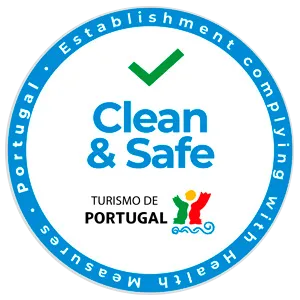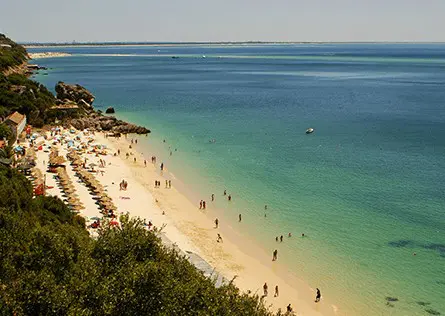
Serra da Arrábida
Situated by the sea, the park offers one of the most dazzling landscapes of the coast near Lisbon. The highest point is in the Sierra de Risco, a magnificent 380 m high peak. Like a green wall plunging into the Atlantic, the mountain range protects small inlets of white sand. Portinho da Arrábida is one of the most beautiful beaches and a good place for scuba diving, with unique fauna and flora that can be discovered in the clean waters of Pedra da Anixa, an islet in front of the beach. You can find out all about it at the Oceanographic Museum, located in the Santa Maria da Arrábida Fortress. Galapos, Galapinhos and the hidden beach of Coelhos are other beaches in this protected landscape worth exploring. Figueirinha beach is one of the busiest. The Reserva Natural do Estuário do Sado has other attractions. Whether it’s the dolphins that accompany us on boat trips or the fact that it is a special place for bird watching, with over 250 species to be spotted. Moinho de Maré da Mourisca is one of the best places for this purpose.
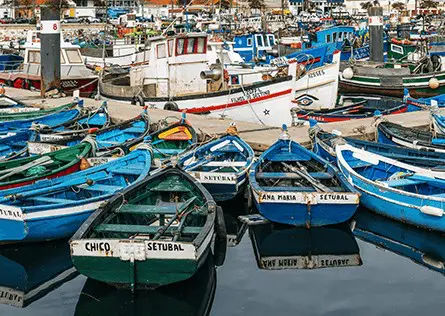
Setúbal – Troia Peninsula
About 50 kilometres south of Lisbon lies the traditionally industrial and port city of Setúbal. It is a place where tourism is increasing every day. A small city, with its squares, its port, and its surroundings with areas of great interest such as Sesimbra, the Serra da Arrábida or the Troia Peninsula. Its tourist attraction is concentrated around a beautiful pedestrianised old town and the possibility of seeing river dolphins in the Sado. It also stands out for its gastronomy. Fish products are its best asset and fried cuttlefish is its most famous dish. It is not for nothing that the best choco frito restaurant is located in the town.
The Troia Peninsula has changed a lot in recent years. Geographically, Troia is a narrow spit of land between the southern bank of the Sado River and the Atlantic Ocean, famous for its dunes and beaches. New urban development projects have been springing up, turning Troia into a high-end tourist centre, with small apartment buildings, a casino and even a congress centre. Fortunately, the beach areas have been well respected and today Troia is home to some of the best beaches to be found around Lisbon.
The best way to get to Setúbal from Lisbon is by car. Leaving by the 25 de Abril Bridge on the A2 road and then on the A12. Toll roads. Another option is by train with the Fertagus company. It has multiple departures a day from Roma-Areeiro, Entrecampos, Sete-Rios and Campolide stations.
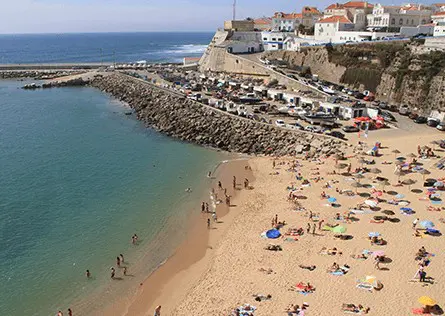
Ericeira
Ericeira is a charming village located about 11 kilometres west of the town of Mafra, in the Lisbon region of Portugal. This village has become an excellent holiday resort, still preserving a beautiful old quarter with a maze of pretty narrow streets and a picturesque fishing harbour. Its port, located at the foot of the cliff, shelters the beach of two fishermen, protected to the north by a breakwater. From Largo das Ribas you can enjoy a beautiful view of the harbour, where fishermen dock their boats and unload their fish, octopus and lobsters. The quality of its beaches and its favourable conditions for surfing have made Ericeira one of the first surfing reserves in the world, being the Ribeira d’ilhas beach an obligatory stop for all lovers of this sport.
To get to Ericeira you can drive to Sintra and from there follow the N247 road. By bus from Lisbon (Campo Grande) with the company ‘Mafrense’.
+ For more information visit https://www.turismoenportugal.org
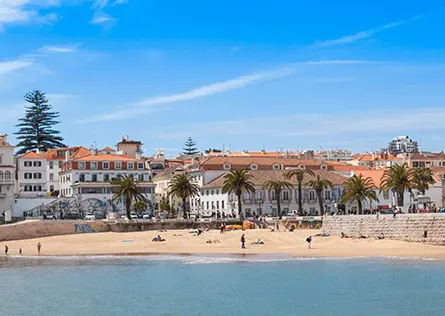
Cascais – Estoril
Cascais and Estoril, or the coast north of Lisbon, became one of the most cosmopolitan and touristic places in Portugal from the moment King Luís I chose the bay as his summer residence at the end of the 19th century. The mild climate and an average of 260 rain-free days a year were certainly a major reason for this choice and for the wealthier families of the time to follow the royal household and have homes and mansions there. It is worth taking a stroll and feeling, even today, the atmosphere of that time. It is pleasant to stroll through the town centre, stroll along the Praia dos Pescadores, enjoy one of its good fish restaurants or listen to the sound of the sea crashing against the rocks of the Boca do Inferno. From there, we can end our visit in Estoril, just two or three kilometres from Cascais, where we can admire its large Casino. If you arrive after sunset, you will find its facade and gardens illuminated.
The easiest way to get there by car from Lisbon is via the IC19 or the A5. By train the best is the ‘Comboio Suburbano’ from Casi do Sodré station (Linha de Cascais).
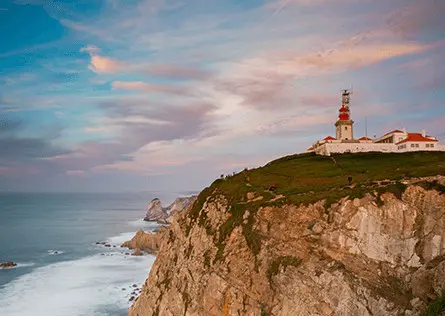
Cabo da Roca
Cape Rock (in Portuguese, Cabo da Roca) is the westernmost cape of mainland Portugal and therefore of the Iberian Peninsula, continental Europe and Eurasia. It was known to the Romans as Promontorium Magnum, and during the age of sailing as the Lisbon Rock.
It is located in the district of Lisbon, in the municipality of Sintra, 40 kilometres west of the Portuguese capital and 18 kilometres west of Sintra, in the Sintra-Cascais Natural Park. Its coordinates are inscribed on a stone plaque on the monument at the site. The cliff emerges from the Atlantic Ocean at approximately 140 metres above sea level. On top of the cliff there is a lighthouse and a tourist shop.
The cape is a popular tourist attraction, and its scenery is often photographed by visitors. Every Sunday morning there is usually a motorcycle rally.
The poet Luís de Camões defined Cape Roca as the place “where the land ends and the sea begins” (Onde a terra acaba e o mar começa).
By car it can be reached from Sintra or Cascais via the N247 road. You can also go by bus from Cascais or Sintra with bus number 403.
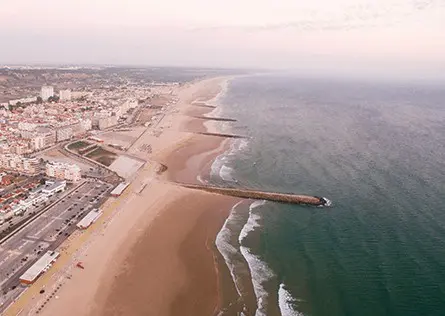
Caparica Beaches
A few kilometres south of the city lies the Costa da Caparica on the Setubal Peninsula. An endless number of white sandy beaches that will delight surfers.
- Nova Praia
- Praia da Saúde
- Praia da Cornélia
- Praia da Mata
- Praia do Forte
- Praia da Riviera
- Praia da Rainha
- Praia do Castelo
- Praia Cabana do Pescador
- Praia do Rei
- Praia da Morena
- Praia da Sereia
- Praia da Princesa
- Praia do Infante
- Praia da Bela Vista
- Praia da Nova Vaga
- Praia Azul
- Praia da Fonte da Telha
The best way to get to the coast is by car. From Lisbon cross the 25 de Abril bridge and take the first exit to Caparica. By ferry from Casi do Sodré to Cacilhas and then bus number 124 or 135. Or from Belém to Porto Brandão and then a bus number 129 or 183. Both routes belong to the company ‘Transportes Sul do Tejo’. From the city itself you can also go directly by bus with the same company: 161 (from Praça Areeiro / Campo Pequeño / Campolide / Alcântara) and 153 (from Praça de Espanha).

